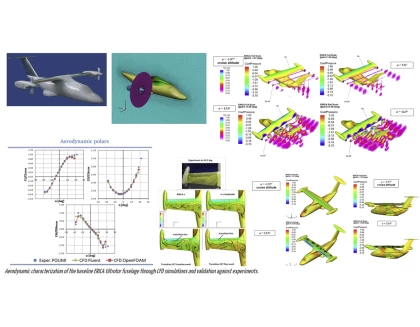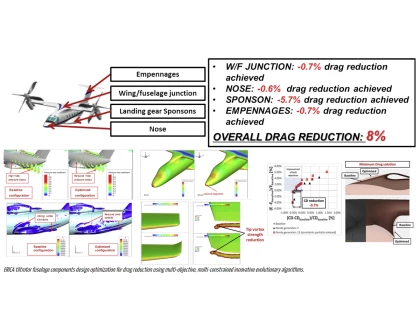
Background
The ERICA tiltrotor concept shares some advantageous features of the traditional tiltrotors with the tilt-wing aircraft, i.e. the capability of tilting the outboard portions of the wings independently from the proprotor. This configuration removes the loss of thrust due to the downwash of the rotors on the wings in helicopter mode, giving the opportunity to reduce the rotor dimensions, so as to improve performance in cruise. In addition, its independent tilt freedom allows the wing to avoid stall, then improving the operational capability of the aircraft during the conversion phase.
Thanks to these characteristics, which also improve the safety of the aircraft, the tiltrotor is expected to encounter a more and more wide demand from citizens in the point to point service. Consequently, this raises the requirement for minimum vehicle drag and hence minimum fuel consumption.
In airplane mode, the role played by parasite drag in the overall power balance becomes more and more important. Therefore, a significant reduction in power requirement is expected to be achieved by improving the aerodynamic efficiency of some key tiltrotor fuselage components.
Strategy
In CODE-Tilt, an automatic design optimization procedure based on the combination of geometry parameterization techniques, an advanced in-house multi-objective optimization tool and CFD simulations, was implemented and applied for re-design of the ERICA tiltrotor empennages, wing/fuselage junction, landing gear sponson and nose, with the aim of minimizing drag.
Thanks to the capability of the optimization tool used to handle multi-objective problems with multiple constraints, all the constraints related to architectural/structural issues, pilot visibility, aircraft stability and controllability were properly taken into account during optimization.
In addition, a series of alternative techniques to the passive design for drag minimization were thoroughly analyzed during the project, specifically the boundary layer suction/blowing on the wing/fuselage junction and the morphing wing concept on the empennages.
Outcomes
Regarding the wing/fuselage junction, the driving optimization objectives were the tail-off aircraft drag minimization and the simultaneous maximization of the lift-to-drag ratio, while being compliant with a series of architectural constraints. A drag reduction on the overall tail-off aircraft equal to 0.7% was achieved against a target of 0.75%. In addition, a study regarding the applicability of boundary layer control over the wing/fuselage junction and its effectiveness in improving stall margin and reducing drag was carried out.
As far as the aircraft nose was concerned, the objective was to minimize drag while taking the pilot visibility constraints into account. A drag reduction on the overall aircraft equal to 0.6% was achieved as per the nose optimization against a target of 0.7%.
Regarding the landing gear sponsons, the aim was to minimize aircraft drag while simultaneously maximizing lift. Moreover, besides geometrical and architectural requirements, a number of constraints on the aircraft longitudinal and lateral stability were set. A drag reduction on the overall aircraft equal to 5.7% was achieved as per the sponson optimization against a target of 1.7%; structural/architectural and stability/controllability constraints were preserved.
Finally, regarding the empennages, the aim was to minimize aircraft drag without undesirable lift reduction. The stability characteristics were taken into account as well in the form of constraints to the optimization problem. Investigated shape modifications included planform shape of the tailplane, fillets between the tailcone-fin junction and between the horizontal tailplane and the fin, insertion of optimal shaped winglet at the tailplane tip. Also the control surfaces (tailplane elevator and vertical rudder) were optimized with the aim of reducing drag, while preserving the same control forces as the baseline and respecting both geometrical and stability constraints. The combination of all the investigated shape modifications provided a total drag reduction of 0.7% on the overall aircraft against a target of 0.4%, with lift and stability characteristics unchanged with respect to the baseline.
As a result of the above-mentioned components optimization, an overall reduction of nearly 8% on the aircraft drag was achieved on the whole, against a target equal to 3.5%.
The optimization results were then validated in a subsequent Clean Sky 1 project, namely DREAm-Tilt, where the optimized shapes were tested at RUAG wind tunnel.
Duration: October 2010-September 2013
This project has received funding from the Clean Sky Joint Undertaking (JU) under grant agreement No. 270609






